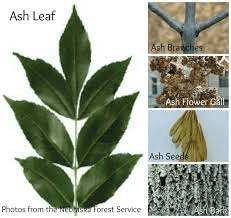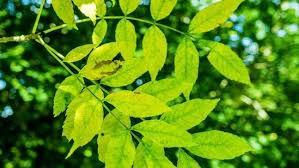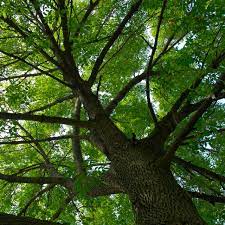Ash trees, belonging to the genus Fraxinus, comprise a group of deciduous trees that are widespread across the Northern Hemisphere. These trees are valued for their timber, ornamental qualities, and ecological significance. Several species of ash trees exist, and some are particularly well-known and widely planted in various regions.
Key features of ash trees include their compound leaves, which typically consist of several leaflets arranged in opposite pairs along a central stem.
The leaves can vary in size and shape depending on the species. Ash trees are dioecious, meaning individual trees are either male or female, and only female trees produce seeds.
One of the most notable species is the European Ash (Fraxinus excelsior), which is native to Europe and has been widely planted as an ornamental and timber tree.
The wood of ash trees is valued for its strength, resilience, and flexibility, making it suitable for various applications such as furniture, tool handles, sports equipment (like baseball bats), and flooring.
In North America, the White Ash (Fraxinus americana) and Green Ash (Fraxinus pennsylvanica) are prominent species. These ash trees have also been widely used for timber, and their wood is prized for its pale color and strength.
Unfortunately, many ash trees in North America have faced the threat of the emerald ash borer, an invasive beetle that has caused widespread damage and mortality among ash tree populations.
Ash trees also play ecological roles in their native habitats. They provide habitat and food for various wildlife species, and their presence contributes to the overall biodiversity of forests and woodlands.
In recent years, ash trees have faced challenges, particularly due to the impact of invasive pests like the emerald ash borer. Efforts are underway to develop strategies to mitigate the effects of these threats and to protect and preserve ash tree populations.
Despite the challenges, ash trees remain an integral part of many landscapes, valued for their aesthetic appeal, ecological contributions, and economic significance.
Ongoing research and conservation efforts aim to address the threats facing these trees and promote their sustainable management and cultivation.
The Botanical Description of Ash Trees
1. Leaf Structure: Ash trees are characterized by compound leaves, typically composed of 5 to 11 leaflets arranged opposite each other on a central stem.
2. Bark Texture: The bark of ash trees is smooth when young, becoming fissured and corky as the tree matures, often forming diamond-shaped patterns.
3. Tree Size: These trees can range from medium to large, with heights varying between species, but generally growing between 50 to 80 feet.
4. Flowers: Ash trees produce small, inconspicuous flowers in spring. These are typically non-showy and greenish in color.
5. Seed Characteristics: The seeds of ash trees, known as samaras or keys, have a distinctive winged structure that aids in wind dispersal.
6. Growth Rate: Ash trees are relatively fast-growing, especially in their early years, providing a quick development of a substantial canopy.
7. Root System: The root system of ash trees is typically shallow, spreading wide, making them susceptible to wind damage in storms.
8. Fall Foliage: In the autumn, ash trees display vibrant and varying hues of yellow, gold, purple, and maroon, enhancing their ornamental appeal.
9. Disease Resistance: Some ash tree species exhibit resistance to certain pests and diseases, making them hardy and durable in various environments.
The Geographic Distribution of Ash Trees
1. North America: Ash trees are prevalent throughout North America, with various species adapting to both temperate and subtropical climates.
2. Europe: European ash trees, particularly the common ash (Fraxinus excelsior), are widespread across the continent, from the British Isles to Eastern Europe.
3. Asia: Ash trees have a notable presence in Asia, with species like the Manchurian ash (Fraxinus mandshurica) being native to regions like China and Korea.
4. Africa: While not as dominant as in other continents, ash trees can be found in certain regions of Africa, adapting to diverse climates.
5. Australia: Introduced species of ash trees can be found in Australia, where they have been cultivated for their ornamental and shade-providing qualities.
6. South America: Some ash species have made their way to South America, either through natural migration or intentional cultivation.
7. Middle East: Certain ash tree varieties are adapted to the Middle Eastern climate, showcasing the tree’s ability to thrive in arid conditions.
8. Canada: Ash trees are indigenous to various parts of Canada, demonstrating their resilience in colder climates.
The Chemical Composition of Ash Trees
1. Flavonoids: These antioxidant compounds are abundant in ash trees and are known for their potential health benefits.
2. Triterpenoids: Present in the bark and leaves, triterpenoids contribute to the tree’s natural defense mechanisms against pests.
3. Phenolic Compounds: Ash trees contain phenolic compounds, known for their anti-inflammatory and antioxidant properties.
4. Lignans: Found in various parts of the tree, lignans have potential antimicrobial and anti-cancer properties.
5. Coumarins: These compounds are involved in the tree’s defense against herbivores and possess anticoagulant properties.
6. Alkaloids: While not present in high concentrations, ash trees may contain alkaloids with potential medicinal properties.
7. Essential Oils: Certain ash species produce essential oils, contributing to their aromatic qualities.
8. Sugars: The sap of ash trees contains sugars, making it a potential source for sweeteners.
9. Terpenes: Found in the leaves and bark, terpenes contribute to the distinct fragrance of ash trees.
10. Quinones: These compounds are involved in the oxidative processes within the tree and may have antioxidant properties.
11. Saponins: Present in varying amounts, saponins contribute to the foaming properties of certain parts of the ash tree.
12. Volatile Organic Compounds (VOCs): VOCs emitted by ash trees may play a role in atmospheric interactions and communication with other organisms.
Read Also: 20 Medicinal Health Benefits Of Arbor Vitae (Thuja occidentalis)
The Medicinal Health Benefits Of Ash Trees (Fraxinus)

1. Anti-Inflammatory Properties: Compounds like flavonoids and phenolic compounds contribute to the anti-inflammatory effects of ash tree extracts.
2. Antioxidant Effects: The presence of various antioxidants helps combat oxidative stress in the body.
3. Pain Relief: Ash tree extracts may have analgesic properties, providing relief from pain and discomfort.
4. Immune System Support: Certain compounds in ash trees may bolster the immune system, promoting overall health.
5. Anti-Cancer Potential: Some studies suggest that components like lignans and coumarins may exhibit anti-cancer properties.
6. Cardiovascular Health: The potential anti-coagulant effects of coumarins contribute to cardiovascular health.
7. Antimicrobial Action: Ash tree extracts may possess antimicrobial properties, helping fight against certain infections.
8. Respiratory Health: Compounds like essential oils may support respiratory health and ease symptoms of respiratory conditions.
9. Diabetes Management: Preliminary research indicates that ash tree components may have a role in managing diabetes.
10. Skin Health: The antioxidant and anti-inflammatory properties of ash tree extracts may contribute to skin health.
11. Digestive Wellness: Ash tree extracts may support digestive health, alleviating issues such as indigestion.
12. Neuroprotective Effects: Some compounds in ash trees may have neuroprotective properties, potentially benefiting cognitive function.
13. Anti-Rheumatic Effects: Ash tree extracts may have potential benefits in managing rheumatic conditions.
14. Anti-Anxiety and Stress Relief: Certain compounds in ash trees may contribute to relaxation and stress relief.
15. Anti-Allergic Properties: Ash tree extracts may help alleviate allergic reactions and symptoms.
16. Liver Health: Components like flavonoids may contribute to liver health and detoxification.
17. Urinary Health: Ash tree extracts may have diuretic properties, benefiting urinary health.
18. Anti-Asthmatic Effects: Compounds found in ash trees may offer relief to individuals with asthma.
19. Bone Health: Some research suggests that ash tree extracts may contribute to bone health and density.
The Methods of Usage to Achieve the Provided Health Benefits Of Ash Trees (Fraxinus)
1. Herbal Infusions: Prepare herbal infusions using ash tree leaves or bark to extract beneficial compounds for internal use.
2. Tinctures: Create tinctures by soaking ash tree parts in alcohol or glycerin to concentrate medicinal properties for controlled consumption.
3. Topical Applications: Develop balms or ointments using ash tree extracts for topical application, aiding in skin health and localized relief.
4. Dietary Supplements: Ash tree extracts can be processed into dietary supplements, offering a convenient way to incorporate their benefits into daily routines.
5. Steam Inhalation: Inhale steam infused with ash tree extracts to promote respiratory health and alleviate congestion.
6. Poultices: Apply poultices made from crushed ash tree leaves or bark directly to affected areas for localized relief from pain or inflammation.
7. Ash Tea: Brew ash tree tea by steeping leaves or bark in hot water, providing a soothing beverage with potential health benefits.
8. Capsules or Pills: Commercially available capsules or pills containing ash tree extracts offer a standardized and convenient dosage.
9. Aromatherapy: Utilize essential oils extracted from ash trees in aromatherapy for relaxation and stress relief.
10. Culinary Use: Incorporate ash tree leaves or bark into culinary creations, adding a unique flavor and potential health benefits to dishes.
The Side Effects Of Using Ash Trees Medicinal Plant
1. Allergic Reactions: Individuals with allergies may experience adverse reactions to certain compounds present in ash tree extracts.
2. Gastrointestinal Distress: Excessive consumption may lead to digestive issues such as nausea, vomiting, or diarrhea.
3. Blood Clotting: The anti-coagulant effects of coumarins may pose a risk for individuals taking blood-thinning medications.
4. Skin Irritation: Topical applications may cause skin irritation in some individuals, necessitating a patch test before widespread use.
5. Respiratory Issues: Inhalation of ash tree extracts may trigger respiratory issues in sensitive individuals.
6. Interactions with Medications: Ash tree extracts may interact with certain medications, impacting their efficacy or causing adverse effects.
7. Liver Complications: High doses of ash tree extracts may have implications for liver health, especially in susceptible individuals.
8. Pregnancy and Breastfeeding: Pregnant and breastfeeding individuals should exercise caution, as the safety of ash tree extracts in these situations is not well-established.
9. Central Nervous System Effects: In some cases, ash tree extracts may cause dizziness, headaches, or other central nervous system-related symptoms.
10. Photosensitivity: Increased sensitivity to sunlight may occur, necessitating sun protection measures during use.
11. Kidney Issues: Individuals with pre-existing kidney conditions should consult healthcare professionals before using ash tree extracts.
12. Diabetic Medications: Ash tree extracts may influence blood sugar levels, requiring monitoring for those on diabetic medications.
13. Hormonal Effects: Some compounds in ash trees may have hormonal effects, requiring caution in individuals with hormone-related conditions.
Read Also: 17 Medicinal Health Benefits Of Saffron (Crocus sativus)
The Scientific Research and Studies of Ash Trees

1. Insect Resistance: Certain ash tree species exhibit natural resistance to specific insect pests, leading to investigations into potential applications for pest control in agriculture.
2. Genetic Diversity: Studies have explored the genetic diversity of ash tree populations, providing insights into their adaptability and resilience.
3. Phytochemical Analysis: Researchers have conducted detailed phytochemical analyses of ash trees, identifying key compounds and their potential applications.
4. Ecological Roles: Ash trees play crucial roles in ecosystems, with studies highlighting their contributions to biodiversity, soil health, and nutrient cycling.
5. Climate Change Impact: Research has investigated how ash tree populations may respond to climate change, considering factors such as temperature, precipitation, and extreme weather events.
6. Conservation Strategies: Given the threats posed by diseases like ash dieback, studies have proposed conservation strategies to preserve genetic diversity and mitigate the impact of such diseases.
7. Medicinal Properties: Numerous studies have explored the medicinal properties of ash trees, investigating their potential in treating various health conditions.
8. Landscape Use: Research has evaluated the landscape and urban use of ash trees, considering their aesthetic value, shade provision, and overall environmental benefits.
9. Wood Properties: Studies on the wood properties of ash trees have been conducted, examining their suitability for various applications, including furniture, flooring, and tool handles.
10. Impact on Wildlife: Ash trees provide habitats for various wildlife species, and research has explored the ecological impact of ash tree decline on these populations.
11. Disease Resistance Breeding: Efforts to breed ash trees with enhanced resistance to diseases like ash dieback have been a focus of scientific research to combat these threats effectively.
The Safety Precautions and Recommendations In Using Ash Trees Medicinal Plant
1. Consultation with Healthcare Professionals: Individuals with existing health conditions or those taking medications should consult healthcare professionals before incorporating ash tree extracts into their wellness routines.
2. Dosage Control: Adhere to recommended dosage guidelines to avoid potential side effects associated with excessive consumption.
3. Allergy Testing: Perform a patch test before using ash tree extracts topically to identify potential allergic reactions.
4. Sun Protection: Due to the possibility of increased photosensitivity, users should take precautions such as sunscreen application during ash tree extract usage.
5. Monitoring Blood Clotting: Individuals taking blood-thinning medications should closely monitor their blood clotting levels, as ash tree extracts may have anti-coagulant effects.
6. Pregnancy and Breastfeeding: Pregnant and breastfeeding individuals should exercise caution, and usage during these periods should be discussed with healthcare providers.
7. Liver Function Monitoring: Regular monitoring of liver function is advisable, especially for those considering prolonged or high-dose usage.
8. Interaction with Medications: Individuals on medication regimens should be aware of potential interactions between ash tree extracts and their prescribed drugs.
9. Children and Elderly: Special consideration is needed for children and the elderly, with dosage adjustments and supervision as necessary.
10. Quality of Products: Ensure the use of high-quality ash tree products obtained from reputable sources to minimize the risk of contaminants or adulteration.
11. Adverse Effects Reporting: Users should promptly report any unexpected or adverse effects to healthcare professionals to facilitate timely intervention.
12. Sustainable Harvesting: For those harvesting ash tree parts for personal use, follow sustainable practices to preserve the health of individual trees and the overall population.
FAQs About Ash Trees Medicinal Plant
1. Is it safe to use ash tree extracts daily for health benefits?
Yes, when used in moderation and following recommended dosage guidelines, ash tree extracts are generally considered safe for daily use.
2. Can ash tree extracts be used by pregnant individuals?
While there is limited research on the safety of ash tree extracts during pregnancy, it’s advisable for pregnant individuals to consult their healthcare providers before incorporating them into their routine. The potential effects on pregnancy and breastfeeding are not well-established.
3. Are there specific ash tree species with more potent medicinal properties?
Various ash tree species may possess different concentrations of beneficial compounds. Research on specific species, such as Fraxinus excelsior, has highlighted their potential health benefits, but it’s essential to consider individual health goals and consult with healthcare professionals.
4. How can I incorporate ash tree extracts into my daily routine?
Ash tree extracts can be consumed as herbal infusions, tinctures, or dietary supplements. Additionally, using them in culinary creations, such as teas or incorporating them into recipes, is a flavorful way to enjoy their potential health benefits.
5. Are there any known drug interactions with ash tree extracts?
Some compounds in ash tree extracts may interact with certain medications. It’s crucial for individuals on medication regimens to consult with healthcare professionals to ensure there are no adverse interactions.
6. Can ash tree extracts be used topically for skin conditions?
Yes, ash tree extracts can be applied topically to the skin, potentially offering benefits for skin health. However, it’s essential to perform a patch test first to check for any adverse reactions.
7. What precautions should individuals with liver conditions take when using ash tree extracts?
Individuals with pre-existing liver conditions should exercise caution and consider regular monitoring of liver function when using ash tree extracts, as high doses may have implications for liver health.
8. How can ash tree extracts support respiratory health?
Ash tree extracts, particularly when inhaled through steam inhalation, may have properties that support respiratory health, providing relief from congestion and other respiratory issues.
9. Are there age restrictions for using ash tree extracts?
While ash tree extracts are generally safe for adults, special consideration is needed for children and the elderly. Dosage adjustments and supervision may be necessary based on individual health and age.
10. What is the recommended dosage for ash tree extracts?
The recommended dosage can vary based on the form of ash tree extract and individual health factors. It’s crucial to follow product-specific guidelines and consult with healthcare professionals for personalized advice.
11. Can ash tree extracts be used for pain relief?
Yes, ash tree extracts may have analgesic properties, potentially offering relief from pain and discomfort. However, it’s essential to use them responsibly and within recommended limits.
12. How can ash tree extracts contribute to cardiovascular health?
The anti-coagulant effects of certain compounds, such as coumarins, present in ash tree extracts may contribute to cardiovascular health by supporting blood flow and circulation.
13. Are there specific ash tree products recommended for dietary supplementation?
High-quality capsules or pills containing standardized ash tree extracts are available commercially for dietary supplementation. Choosing reputable products ensures a consistent and controlled dosage.
14. Can ash tree extracts be used for stress relief?
Certain compounds in ash tree extracts may have relaxing properties, contributing to stress relief. Aromatherapy, topical applications, or herbal infusions can be methods for utilizing these potential benefits.
15. Are there concerns about ash tree extracts causing allergies?
Individuals with allergies should be cautious, as some compounds in ash tree extracts may trigger allergic reactions. Performing a patch test and seeking guidance from healthcare professionals is advisable.
16. How can ash tree extracts support digestive wellness?
Ash tree extracts may contain compounds that support digestive health and alleviate issues such as indigestion. Incorporating them into herbal teas or dietary supplements may be beneficial.
17. Can ash tree extracts be used as a natural sweetener?
While ash tree sap contains sugars, its use as a natural sweetener is not common. Other sources may be more suitable for this purpose, and it’s essential to consider individual dietary needs and preferences.

